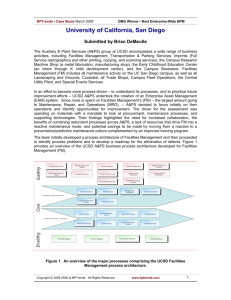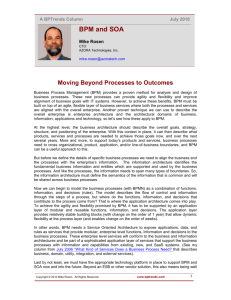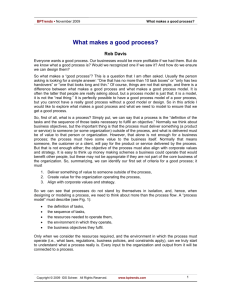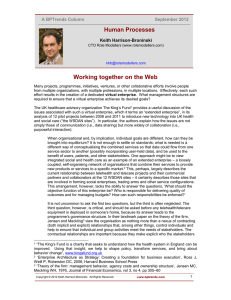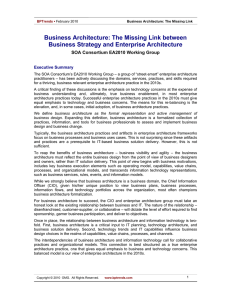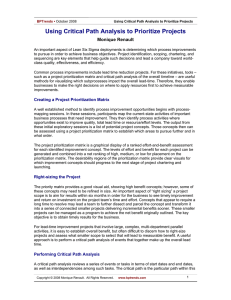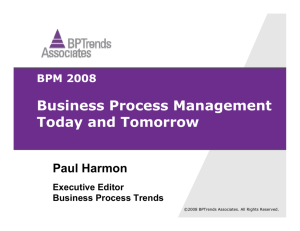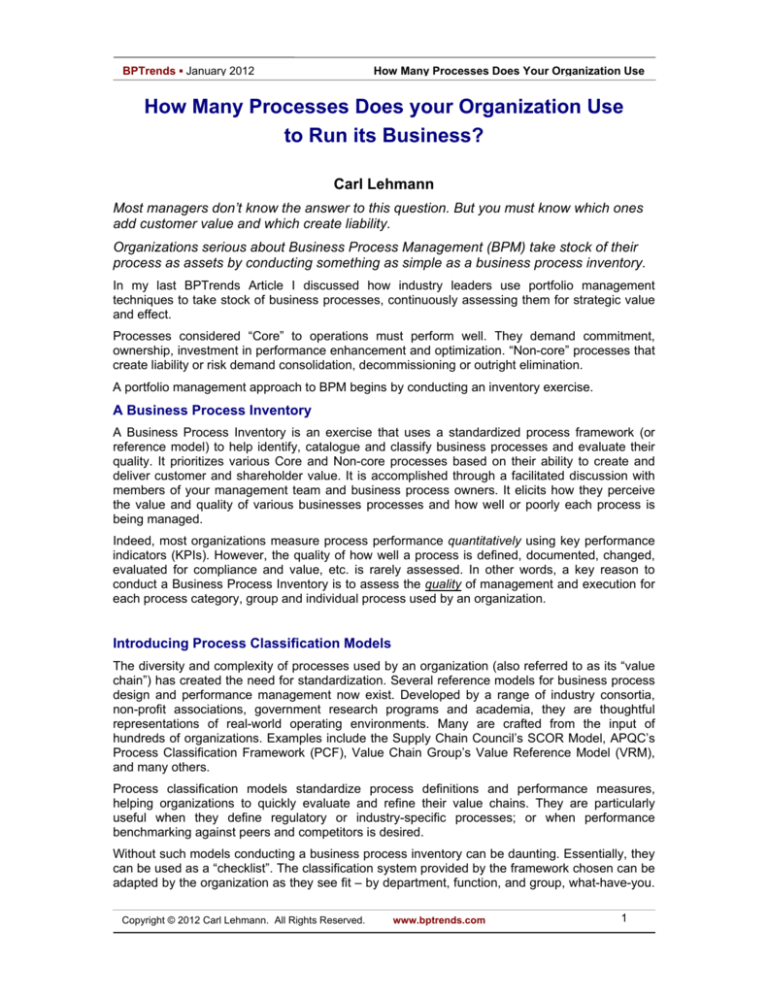
BPTrends ▪ January 2012
How Many Processes Does Your Organization Use
How Many Processes Does your Organization Use
to Run its Business?
Carl Lehmann
Most managers don’t know the answer to this question. But you must know which ones
add customer value and which create liability.
Organizations serious about Business Process Management (BPM) take stock of their
process as assets by conducting something as simple as a business process inventory.
In my last BPTrends Article I discussed how industry leaders use portfolio management
techniques to take stock of business processes, continuously assessing them for strategic value
and effect.
Processes considered “Core” to operations must perform well. They demand commitment,
ownership, investment in performance enhancement and optimization. “Non-core” processes that
create liability or risk demand consolidation, decommissioning or outright elimination.
A portfolio management approach to BPM begins by conducting an inventory exercise.
A Business Process Inventory
A Business Process Inventory is an exercise that uses a standardized process framework (or
reference model) to help identify, catalogue and classify business processes and evaluate their
quality. It prioritizes various Core and Non-core processes based on their ability to create and
deliver customer and shareholder value. It is accomplished through a facilitated discussion with
members of your management team and business process owners. It elicits how they perceive
the value and quality of various businesses processes and how well or poorly each process is
being managed.
Indeed, most organizations measure process performance quantitatively using key performance
indicators (KPIs). However, the quality of how well a process is defined, documented, changed,
evaluated for compliance and value, etc. is rarely assessed. In other words, a key reason to
conduct a Business Process Inventory is to assess the quality of management and execution for
each process category, group and individual process used by an organization.
Introducing Process Classification Models
The diversity and complexity of processes used by an organization (also referred to as its “value
chain”) has created the need for standardization. Several reference models for business process
design and performance management now exist. Developed by a range of industry consortia,
non-profit associations, government research programs and academia, they are thoughtful
representations of real-world operating environments. Many are crafted from the input of
hundreds of organizations. Examples include the Supply Chain Council’s SCOR Model, APQC’s
Process Classification Framework (PCF), Value Chain Group’s Value Reference Model (VRM),
and many others.
Process classification models standardize process definitions and performance measures,
helping organizations to quickly evaluate and refine their value chains. They are particularly
useful when they define regulatory or industry-specific processes; or when performance
benchmarking against peers and competitors is desired.
Without such models conducting a business process inventory can be daunting. Essentially, they
can be used as a “checklist”. The classification system provided by the framework chosen can be
adapted by the organization as they see fit – by department, function, and group, what-have-you.
Copyright © 2012 Carl Lehmann. All Rights Reserved.
www.bptrends.com
1
BPTrends ▪ January 2012
How Many Processes Does Your Organization Use
For example, organizations can use APQC’s PCF to inventory the processes in the framework
they use, flag those they don’t use, and add processes unique to it – thus reconciling the
framework – to represent its value chain. This greatly simplifies the effort needed to inventory and
classify processes from scratch.
Next, the management team can evaluate the quality, or lack thereof, of each process category,
group or individual process and determine what is to be done with the “Core” processes
necessary to create and deliver customer and shareholder value, and those that do not. Various
quality evaluation criteria can be established to this end. BPMethods developed an inventory and
evaluation worksheet for this purpose. Process quality can be assessed across several
standardized evaluation criteria. As BPM initiatives and process automation and/or improvement
projects take shape each process can then be periodically evaluated over a timeline to measure
quality, outcomes, improvement, sustainability, etc. – thus establishing a process lifecycle
management technique and the foundation for a Continuous Process Improvement Program.
The key benefit of conducting a business process inventory in this way is that it’s simple! “Big
Bang” approaches such a Carnegie Mellon’s Capability Maturity Model (CMM), Six Sigma, Lean,
et al, are all great, but they frighten management teams unfamiliar with them – especially in small
to mid-sized firms. If you can’t engage your management team to begin BPM with a simple
inventory exercise, a Big Bang approach won’t be any easier.
Oh, and when you do, you’ll know exactly how many processes you use to add customer value to
your business.
A Business Process Inventory is a critical and yet simple method to take stock of
business processes as strategic assets and managing their overall lifecycle performance
as part of a Continuous Process Improvement Program.
------Author
Carl F. Lehmann is a business process management (BPM) specialist. He helps organizations
improve execution, performance and outcomes through efficient process design. His career
spans nearly three decades during which he developed and brought high-tech products and
services to market, and helped organizations use high-tech products and services to run their
businesses.
BPTrends Linkedin Discussion Group
We created a BPTrends Discussion Group on Linkedin to allow our members, readers and
friends to freely exchange ideas on a wide variety of BPM related topics. We encourage you to
initiate a new discussion on this publication, or on other BPM related topics of interest to you, or
to contribute to existing discussions. Go to Linkedin and join the BPTrends Discussion Group.
Copyright © 2012 Carl Lehmann. All Rights Reserved.
www.bptrends.com
2

